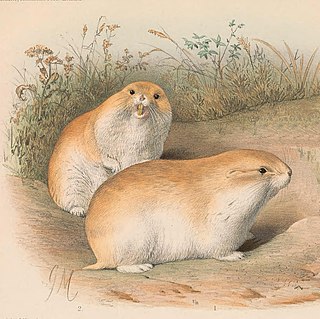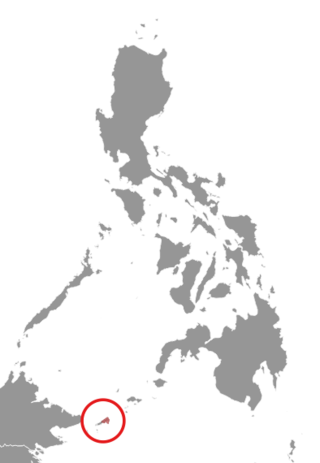
Water voles are large voles in the genus Arvicola. They are found in both aquatic and dry habitat through Europe and much of northern Asia. A water vole found in Western North America was historically considered a member of this genus, but has been shown to be more closely related to members of the genus Microtus. Head and body lengths are 12–22 cm, tail lengths are 6.5–12.5 cm, and their weights are 70–250 g. The animals may exhibit indeterminate growth. They are thick-furred and have hairy fringes on their feet that improve their swimming ability.
Reig's grass mouse is a South American rodent species found in Brazil and Uruguay. It is named after Argentine biologist Osvaldo Reig (1929–1992).

Herbert's rock-wallaby is a member of a group of seven very closely related rock-wallabies found in northeastern Queensland, Australia. Herbert's is the most southerly and most widespread of the group.
Olrog's chaco mouse is a species of South American rodent in the family Cricetidae, endemic to Argentina. The natural habitat of the species is hot deserts. Its karyotype has 2n = 60. The species is named after Swedish-Argentine biologist Claes C. Olrog.
Robert's snow vole is a species of rodent in the family Cricetidae. It is found in Azerbaijan, Georgia, the Russian Federation, and Turkey. Its natural habitats are temperate forests and temperate grassland.

Przewalski's steppe lemming is a species of rodent in the family Cricetidae. It is found in China and Mongolia.
Pratt's vole, also called the Sichuan red-backed vole, is a species of rodent in the family Cricetidae. It is endemic to Mount Emei, Sichuan, China. It was named in 1891 for Antwerp Edgar Pratt.
Peterson's chinchilla mouse is a species of rodent in the family Cricetidae and is found in west central and southern Argentina and nearby areas of Chile. The species is named after American paleontologist Olaf A. Peterson (1865–1933).
The ranee mouse is a species of rodent in the family Muridae. It is restricted to the island of Borneo, in the provinces of Sarawak (Malaysia) and Sabah (Malaysia). Its natural habitat is subtropical or tropical dry forests.
Oligoryzomys arenalis, also known as the sandy colilargo or sandy pygmy rice rat, is a species of rodent in the genus Oligoryzomys of family Cricetidae. It is found in the Andes of Peru at 400 to 2850 m altitude, but may include more than one species.

Handleyomys chapmani, also known as Chapman's oryzomys or Chapman's rice rat, is a species of rodent in the genus Handleyomys of family Cricetidae. It is found only in Mexico. It was previously placed in Oryzomys as Oryzomys chapmani, but has been provisionally transferred to the genus Handleyomys pending the description of a new genus to contain it.
Hopkins's groove-toothed swamp rat is a species of rodent in the family Muridae. It is found in Kenya, Rwanda, Uganda, possibly Burundi, and possibly Tanzania. Its natural habitat is swamps. It is threatened by habitat loss.
Stirton's deer mouse is a species of rodent in the family Cricetidae. It is found in El Salvador, Guatemala, Honduras, and Nicaragua. P. stirtoni is widely distributed and is presumed to have a large population and a tolerance of habitat destruction, though its biology is poorly understood. The species is named after Ruben A. Stirton (1901-1966), an American zoologist associated with the University of California at Berkeley.

The Tawitawi forest rat or Tawitawi Island rat is a species of rodent in the family Muridae. It is found only in Tawi-Tawi, Philippines.

Tate's shrew rat is a species of rodent in the family Muridae. It is found only in central Sulawesi, Indonesia, where it has been recorded on Mount Latimodjong, Mount Tokala, and Mount Nokilalaki. The species is named after American zoologist George Henry Hamilton Tate.
Phillips's gerbil is a species of rodent found in Ethiopia, Kenya, and Somalia. Its natural habitat is subtropical or tropical dry shrubland.

The Gebe cuscus is a species of marsupial in the family Phalangeridae. It is endemic to the island of Gebe, North Maluku province, Indonesia, where it lives at elevations from sea level to 300 m.

The elegant water shrew is a species of mammal in the subfamily Soricinae of the family Soricidae. It is the only species within the genus Nectogale. It lives in Sikkim and China.
Geoxus annectens, also known as Pearson's long-clawed akodont or Pearson's long-clawed mouse, is a species of rodent in the tribe Abrotrichini of family Cricetidae. Molecular data suggests that its closest relative is Geoxus valdivianus. Formerly classified in its own genus, Pearsonomys, named after American zoologist Oliver Payne Pearson, it was moved to Geoxus in 2016 after a morphological and genetic reevaluation of the tribe Abrotrichini. This rodent is endemic to Chile, where it is found in Nothofagus forest of the Valdivian temperate rainforest ecoregion.
Goldman's pocket gopher, is a species of rodent in the pocket gopher family. It is distributed throughout northern Mexico. It was formerly considered a subspecies of the yellow-faced pocket gopher. It is named after Edward Alphonso Goldman, who collected the holotype of this species.









